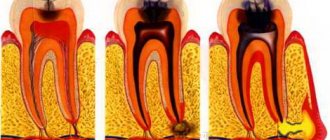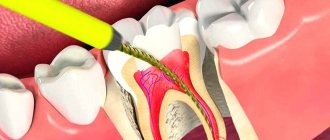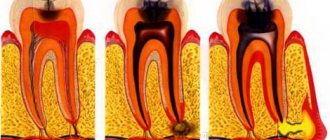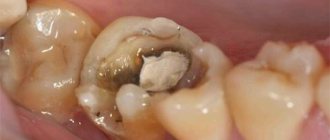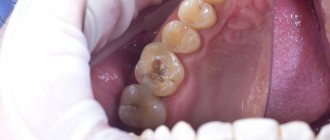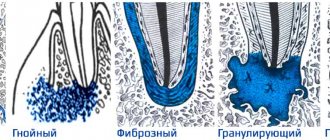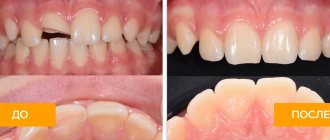During the examination, the dentist may suggest that you replace the previously installed filling with a new one. This proposal is often misunderstood:
“Doctor, this tooth doesn’t bother me, and the filling is still holding. Why change it?!”
To understand why replace an old filling with a new one, let’s figure it out: what is the function of the filling and why was it placed in the first place?
The filling restores the function of the tooth, aesthetics, protects the pulp (dental nerve) from infection, and the tooth from further destruction.
If the destruction of enamel and dentin has gone so deep that it has approached the pulp of the tooth, the “nerve” will need to be removed. “But it can be treated,” you say. Of course, the doctor will remove the tooth pulp, fill the canals and put a filling. You will learn more about canal treatment in the article Why you cannot give a 100% guarantee on tooth root canal treatment.
The problem is that after complex, lengthy and expensive root canal treatment, the tooth will become “dead” - these are not empty words. After removal of the pulp, hard tissues cease to be moistened and the walls of the tooth become fragile. Pulpitis shortens the lifespan of your tooth.
Now let's get back to replacing the old filling with a new one. The main reason for replacing an old filling with a new one is the loss of tightness of the filling of a former carious cavity. If the old filling does not prevent infection from entering the tooth, then the carious process resumes, and we already know what the consequences are.
Secondary caries develops unnoticed and cannot be detected without examination by a dentist.
In what other cases is it necessary to replace an old filling with a new one?
Symptoms
Visiting the dentist and getting dental treatment is accompanied by unpleasant sensations and discomfort. Pain can and should be present after therapeutic measures. But it goes away after a short period of time.
If pain persists, then under no circumstances should it be ignored. They will lead to the development of inflammatory processes. The result is a damaged tooth.
Signs of an incorrectly installed seal include:
- Inability to clench or clench teeth. It feels like the filling is too high and protrudes above all the teeth. Therefore, when chewing or moving the jaw, there is a feeling of a foreign object in the mouth.
- A feeling of pain that intensifies when chewing. It occurs due to both over- and under-inflated fillings.
- Sharp or overhanging edges. The filling may have a tight fit to the bite, but at the same time cause injury to the gums or tongue. These injuries can lead to the development of stomatitis.
- Permanent injury to the papilla. This is caused by incorrect actions of the dentist, who did not preserve the interdental gaps during treatment. As a result, it becomes difficult to brush your teeth and your gums begin to bleed.
The norm is the presence of discomfort and pain in the first 3-4 days after dental treatment. Everything should go away on its own after this period. But if the discomfort persists, then you should immediately contact your dentist so that he can eliminate this problem. Most often this takes a few minutes and does not require additional intervention.
How does the replacement work?
Let us note right away that the procedure is carried out under local anesthesia and discomfort is minimized due to this.
In general, replacing a filling is carried out as follows:
- anesthesia is administered;
- the desired tooth is isolated from the rest by a rubber dam in order to protect them from pathogenic microorganisms;
- the old filling is removed, the tissues are cleaned of caries if necessary;
- the cavity is treated with drugs and dried;
- make an insulating or medicinal pad;
- a new filling is installed.
If we are talking about restoration, then it is carried out taking into account all the anatomical features of the chewing surface.
Remember that regular preventive examinations help to identify pathologies and defects in a timely manner. Agree, it is better to spend a few minutes polishing the filling than to replace it globally after some time. This will not only save you money, but also keep your teeth and nerves healthy.
Causes of an incorrectly installed seal
After treating a tooth, the dentist must install a filling that will protect and isolate sensitive tissues from bacteria and microbes entering the resulting cavity.
The filling material undergoes a polymerization process and then must be properly sanded. At this stage, the doctor monitors and corrects its fit to the tooth, as well as its position relative to the gums, cheeks, and tongue.
The most common causes of toothache after a filling is installed are:
- Oversized filling.
- The solution has shrunk.
- The treatment procedure was carried out in violation.
- Inflammatory began in the canals.
- Poor quality filling material.
- Allergy.
- Incorrect diagnosis and, accordingly, treatment.
- There was an infection in the dental canals.
Let's find out why a tooth hurts after a temporary filling
To control the protruding edges of the filling material, its position relative to the rest of the teeth and the bite, the dentist uses a special coloring strip. The test is that the patient must bite it several times. If the doctor sees that there are no obstacles, then he begins polishing.
This is a very important stage, because if you make a mistake and do not notice the protruding edges of the filling, they will cause problems with chewing food and oral hygiene, which will lead to the development of negative consequences and various diseases.
How long does a filling last?
The minimum service life of a filling is considered to be 3-5 years. Some materials last longer, up to 10 years. Much depends on the condition of the treated tooth after the minimum period.
What affects the service life of the filling:
- how correctly the dentist selected the size and installed the filling;
- the material from which it is made;
- what is the thickness of the walls of the abutment tooth and what condition is it in;
- what hygienic care is required: abrasiveness of pastes, hardness of the brush, use of special products;
- whether the patient has bad habits that have a harmful effect on the filling material;
- how much solid or tough food is in the diet, whether the temperature of food and drinks is moderate, etc.
What to do
There are several ways that a new filling can cause discomfort. Among them:
- Wrong size. It may be too big or small for the tooth.
- Poorly installed and polished filling. The filling material protrudes from one side of the tooth, causing additional discomfort.
Any of these problems can lead to further tooth decay. It is better not to try to correct the situation on your own, but if you notice the first symptoms, immediately contact your dentist.
The doctor must properly sand the filling material. The adjustment will take a maximum of 5-10 minutes.
Some people are in no hurry to seek help from a specialist because they mistakenly believe that the filling itself will wear off over time and stop causing discomfort. But the modern material that dentists use is more durable. A high-quality filling will shrink and begin to wear off only after a few years.
Home treatment methods
As mentioned above, it is impossible to get rid of the problem at home, and it is unreasonable to expect natural abrasion of the material.
To alleviate the condition before visiting a specialist, you need to follow certain recommendations:
- Avoid eating hard foods that require biting. The sealed unit, due to its higher location, is subject to the main load, and this is fraught with a fracture of its base.
- Eliminate hot foods from your diet. This is because such foods and drinks can cause swelling of the soft tissues, increasing the discomfort.
- For severe pain, analgesics or non-steroidal anti-inflammatory drugs can be used. However, you should not abuse such drugs, because their use is limited - no more than 5 days.
Doctor's actions
The dentist must act and take measures based on the reasons that led to discomfort after dental treatment. There may be several situations:
- The discomfort does not go away within several days. You should definitely visit a doctor who will polish the filling in a couple of minutes. Otherwise, negative consequences may begin to develop and tooth decay may occur.
- If the edges of the filling are too sharp, they can cause injury to the gums, tongue or cheek. In this case, you should immediately visit the dentist so that he can immediately polish the filling, thereby preventing possible injuries.
- A crack remains between the filling and the surface of the tooth. You should definitely see a doctor again, as bacteria and microbes will get into the gap that has formed, which will trigger the development of caries.
Also, do not ask the doctor to file down the filling too much. The teeth of the upper and lower jaws must be in close contact with each other while chewing food. If this does not happen, then the person’s bite will be disrupted.
Is it always possible to replace an old filling with a new one?
Depending on the degree of tooth decay and aesthetic requirements, restoration can be done:
1. Filling made of composite material. As a rule, if the tooth decay is less than 50%
2. Veneer or componir in case of restoration of the anterior group of teeth - Veneer - the thinnest porcelain plate made in a dental laboratory using an individual impression - Componir - a budget analogue of a veneer, made in a factory from composite materials
3. Inlay made of composite material or ceramics. In case the tooth is destroyed by more than 50%. An inlay is a “large” filling that is made in a dental laboratory. It is much stronger than a filling and better conveys the anatomical features of the teeth and matches the color
4. A crown made of metal ceramics or zirconium dioxide. A crown is installed in case of significant tooth decay
If the crown part of a tooth is completely destroyed, then a crown will be the best solution to preserve it, since under heavy chewing load the wall of a tooth covered with a filling may break off, and if the crack goes under the gum, then the tooth will have to be parted with.
Possible consequences
If the dentist installed the filling incorrectly, and the patient is afraid or does not want to go back to fix this problem, then there is a high probability of negative consequences developing. These include:
- Pulpitis and periodontitis. They are the result of an over-inflated filling. That is, there is constant and strong pressure on the tooth, which leads to chronic injury. Because of this, the enamel on a person’s teeth wears off, which leads to the re-formation of caries. If the filling is not corrected in a timely manner, the tooth will have to be depulped.
- Chipped tooth surface. It also occurs due to constant pressure on the tooth that has been filled.
- Dislocation. It can happen if, when closing the mouth, the teeth close unevenly and incorrectly on different sides. In other words, a misalignment occurs and pathology of the temporomandibular joints develops. The main signs of this problem are: pain, crunching, clicking.
After the treatment, it is very important how the dentist filled the tooth. If the filling begins to interfere with the motor functions of the lower jaw, then it is worth telling the doctor about this so that he can polish it again.
It’s easy to check if the filling is in the way. You just need to move your lower jaw to the right, left, forward, and also leave your mouth open. If you feel pain or discomfort, you should immediately inform your dentist so that he can fix the problem.
People who do not want to go for a second appointment mistakenly believe that over time the filling will wear off and stop causing discomfort. Of course, a feeling of addiction may arise, but it will not in any way affect the solution to the problem. You cannot do without the help of a dentist.
The sooner you re-visit the doctor and adjust the filling, the lower the risk of developing negative consequences and dental diseases.
Expert advice
The arrangement of teeth in a row was initially determined by nature, so the elements must touch correctly for the full implementation of the chewing function. A change in the bite can cause an incorrect distance between the jaws. Once such a pathology develops, it will be much more difficult for the doctor to eliminate it.
To minimize the likelihood of complications, the patient must take certain actions himself. If bite defects are observed within a few days after installing the composition, you should immediately consult a dentist. Correcting the filling will take a few minutes, but these manipulations will help prevent the development of disorders.
After installing the material, some people complain about roughness and stepped placement of the composition. Pathogenic microorganisms can accumulate in the formed cavities, which will lead to the development of secondary caries. In such cases, it is also necessary to urgently visit the dentist's office.
Category Dental filling Posted by Mister stomatolog
A filling fell out, my tooth hurts, what should I do?
If your tooth is sensitive after losing a filling, you most likely have open dentinal canals. Dentin canals are tiny connections between the dentin and the pulp of your tooth.
Since the only sensation that the nerves in the pulp can send to your brain is pain, without a filling, your tooth may react quite painfully to hot and cold drinks and food. Over-the-counter pain relievers may help relieve this pain (check with your doctor).
A temporary solution to stop the source of pain can be ordinary cotton wool. Since the pain is caused by open dentin canals, you can try to temporarily close them until you see your dentist. Close the dentinal canals in the exposed area of the tooth by temporarily filling it with cotton wool.
In what cases is it necessary to install a filling?
The installation of restorative material is carried out not only in the treatment of carious lesions. The procedure is also performed when:
- presence of chips and cracks;
- elimination of consequences after mechanical damage;
- intense loss of hard tissues, leading to almost complete wear of the upper part of the teeth (for example, due to involuntary grinding of the jaws).
It is worth noting that any dental clinic performs filling only in cases where the destruction of the coronal part is insignificant. If the surface of the tooth is damaged by more than a third, it is replaced with an artificial substitute - a prosthesis.
The use of modern materials helps restore the beauty of the smile and chewing function, and also prevents further destruction of the mineralized coating.
